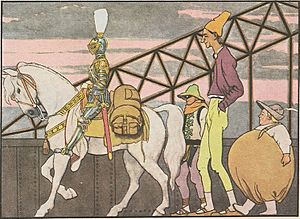Long, Broad and Sharpsight facts for kids
Long, Broad and Sharpsight is a classic fairy tale from Bohemia, which is now part of the Czech Republic. This exciting story was first written down by Karel Jaromír Erben in 1865. It tells the tale of a brave prince and his three amazing friends, each with a special power. Together, they face a powerful sorcerer to rescue a beautiful princess.
Contents
The Prince's Quest
Once upon a time, an old king wanted his son to get married before he passed away. The prince didn't know who to marry. So, his father sent him to a mysterious tower room. This room had been locked for many years.
Inside, the prince found windows that showed images of beautiful women. He saw one window covered by a curtain. When he pulled it back, he saw a princess and immediately fell in love. He told his father about her. The king was sad, explaining that this princess was trapped by an evil sorcerer in an iron castle. But since the prince had given his word, he had to try and save her.
Meeting Amazing Friends
On his journey, the prince met a tall man named Long. Long could stretch himself incredibly far. He showed his power by reaching up to a very tall tree and taking down a bird's nest. The prince was impressed and asked Long to join him.
Next, they met Broad. Broad could make himself grow as big as a mountain! He was very strong. The prince also invited him to come along.
Finally, they met Sharpsight. Sharpsight kept his eyes covered with a bandage. He explained that without it, his gaze was so strong it could set things on fire or break them into pieces. He could see through anything, even the bandage. The prince welcomed Sharpsight to their group.
The Iron Castle Challenge
The prince and his three companions soon reached the iron castle. As soon as they stepped inside, the gates slammed shut behind them. They found many men turned to stone statues. There was also a feast laid out, so they ate the food.
Soon, the sorcerer appeared with the princess. He told the prince he could marry the princess if he could keep her from escaping for three nights. The prince tried to talk to the princess, but she didn't say a word.
The First Night
As the prince and his friends fell asleep, the princess vanished! But Sharpsight, with his amazing vision, spotted her. She had turned into a tiny acorn on a tall oak tree far away. Long quickly stretched himself, reached the tree, and brought the acorn back. The sorcerer was furious when he saw her return.
The Second Night
The next day, the princess disappeared again. This time, she had turned into a precious stone on a distant mountain. Sharpsight saw her once more. Long stretched out again and brought the sparkling stone back to the castle. The sorcerer was even angrier!
The Third Night
On the third night, the princess tried to escape one last time. She turned into a golden ring and hid inside a shell deep in the sea. This was the hardest challenge yet! Long knew he couldn't get the ring alone. He took Broad with him.
Broad made himself incredibly huge and began to drink all the water from the sea! As the sea level dropped, Long was able to find the golden ring in the shell. They started to head back, but Broad was so full of water that Long couldn't carry him. Broad accidentally let all the water out, and he almost drowned! But they managed to make it back to the castle just in time.
Victory and Farewell
The sorcerer was defeated! He turned into a crow and flew away. All the men who had been turned to stone came back to life. The prince took the princess home, and they were married. Long, Broad, and Sharpsight had completed their task. They left the prince's service to seek their own adventures.
Different Versions of the Story
This popular fairy tale has been told and translated in many ways. For example, Andrew Lang included it in The Grey Fairy Book as Long, Broad and Quickeye. Another version was called Longshanks, Girth, and Keen. These different names show how widely known and loved this Bohemian tale is around the world.


